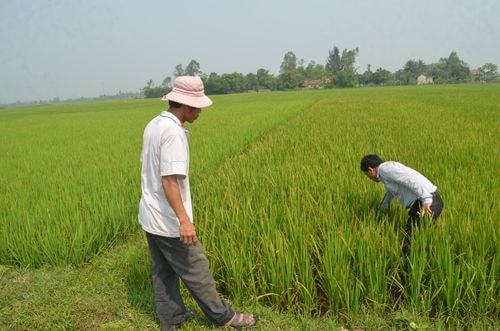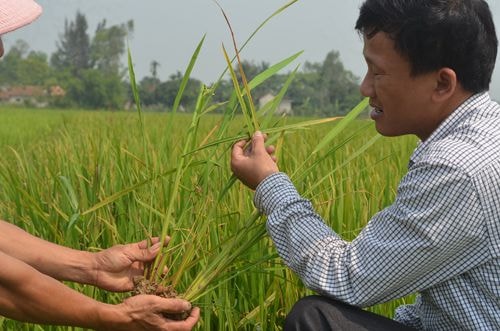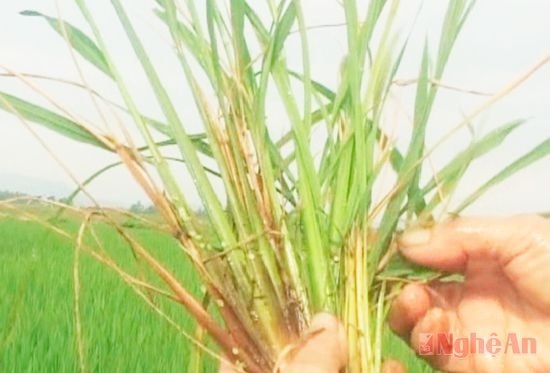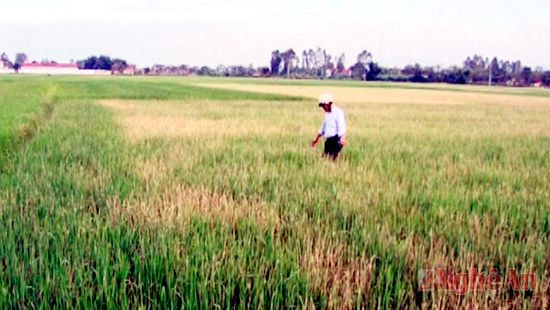More than 1,000 hectares of spring rice are infected with yellow leaf disease of unknown cause.
(Baonghean.vn) - Currently, in spring rice fields in many localities in the province, more than 1,000 hectares of rice are infected with yellow leaves, mainly concentrated in Nam Dan 350 hectares, Dien Chau nearly 400 hectares, Quynh Luu over 250 hectares and many districts in the plains, some communes in lowland districts.
 |
| Rice is heavily infected with yellow leaves in Quyet Tien hamlet - Hung Tien commune (Hung Nguyen) for unknown reasons. |
The infected area is mainly concentrated in pure rice varieties such as Khang Dan 18, BC15, NA2, VF1 and some high-quality fragrant rice varieties. The infected area is mainly in dry rice fields and rice fields that are holding panicles and have not yet blossomed.
Many rice fields are heavily infected with over 40% of the rice leaves on the plants being infected and unable to recover, which can affect the yield and quality of the crop. This is the first spring crop where yellow leaf disease has appeared on a large scale, the cause has not been determined, so farmers are very worried but do not dare to spray or prevent it.
 |
| Rice infected with yellow leaves in Xuan Hoa |
According to Mr. Phan Duy Hai - Deputy Head of the Provincial Plant Protection Department, the initial cause was determined to be due to unfavorable weather conditions leading to heat shock and poisoning in rice varieties with weak resistance, caused by rice blast disease, or due to farmers' irregular rice cultivation and fertilization processes.
Currently, the Provincial Plant Protection Department is coordinating with Plant Protection stations and local authorities in districts to direct people to actively provide enough water for rice, fertilize scientifically, and use foliar fertilizers to prevent the risk of grain smut and loss of productivity.
The most important thing now is that specialized agencies need to quickly find the cause and effective prevention solutions so that farmers can feel secure in production, especially in the condition that rice blast disease is appearing widely and has the risk of spreading.
Luong Mai
* Currently, over 6,000 hectares of spring rice in Nam Dan are in the final stages of panicle initiation and flowering. Due to the erratic weather, alternating between monsoons, not only has rice blast disease occurred, but recently, many areas of spring rice have also shown signs of yellowing leaves.
 |
| Yellow leaves phenomenon on rice plants |
It can be said that, thanks to the drastic implementation of preventive measures, up to this point, Nam Dan has completely controlled rice blast disease, ensuring that 100% of the area enters the flowering phase safely.
However, in recent days, yellow leaves have appeared on rice plants in an area of more than 330 hectares, mainly on pure rice varieties such as HT1, NA2, sticky rice 352, Khang dan 18, most concentrated in dry fields. Communes with large areas of yellow leaves are Hung Tien, Nam Nghia, Xuan Hoa, Kim Lien, Xuan Lam, Hong Long.
Through monitoring and inspection, the Plant Protection Station of Nam Dan district determined that this was not a disease caused by fungi, bacteria or viruses, but a physiological phenomenon due to sudden changes in weather from cold air to hot sun, with a large difference in day and night temperatures. On the other hand, the rice plant is in the stage of heading and flowering, so it is very sensitive to external conditions that cause the rice leaves to turn yellow.
 |
| The rice area with yellow leaves is more than 330 hectares. |
Faced with the above situation, the Plant Protection Station of Nam Dan district has recommended that farmers need to ensure adequate water sources and can use some types of micronutrient fertilizers, foliar fertilizers rich in micronutrients (Zn, Cu, Mn...) to spray to help rice leaves recover quickly. Absolutely do not use foliar fertilizers to stimulate growth on rice areas infected with diseases such as leaf blight, bacterial stripe spot...
Article: Kim Dung
Photo: Dau Thang
(Nam Dan Radio and Television Station)






